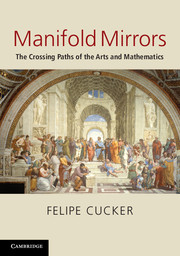Book contents
- Frontmatter
- Contents
- Mathematics: user's manual
- Appetizers
- 1 Space and geometry
- 2 Motions on the plane
- 3 The many symmetries of planar objects
- 4 The many objects with planar symmetries
- 5 Reflections on the mirror
- 6 A raw material
- 7 Stretching the plane
- 8 Aural wallpaper
- 9 The dawn of perspective
- 10 A repertoire of drawing systems
- 11 The vicissitudes of perspective
- 12 The vicissitudes of geometry
- 13 Symmetries in non-Euclidean geometries
- 14 The shape of the universe
- Appendix: Rule-driven creation
- References
- Acknowledgements
- Index of symbols
- Index of names
- Index of concepts
14 - The shape of the universe
Published online by Cambridge University Press: 05 May 2013
- Frontmatter
- Contents
- Mathematics: user's manual
- Appetizers
- 1 Space and geometry
- 2 Motions on the plane
- 3 The many symmetries of planar objects
- 4 The many objects with planar symmetries
- 5 Reflections on the mirror
- 6 A raw material
- 7 Stretching the plane
- 8 Aural wallpaper
- 9 The dawn of perspective
- 10 A repertoire of drawing systems
- 11 The vicissitudes of perspective
- 12 The vicissitudes of geometry
- 13 Symmetries in non-Euclidean geometries
- 14 The shape of the universe
- Appendix: Rule-driven creation
- References
- Acknowledgements
- Index of symbols
- Index of names
- Index of concepts
Summary
Euclidean, hyperbolic, projective, spherical… The adjectives seem to multiply and give place to a collection of geometries, each asserting its own particular nature of space. Is there a true geometry among them? Can one of them lay claim to offer a faithful description of reality?
A fully satisfying answer to these questions is likely not possible. To begin with, there is no agreement among philosophers of what reality is. Furthermore, even the adoption of a down-to-earth approach to reality – the assumption that the latter is the physical universe as studied and described to us by natural scientists – stubbornly offers resistance to a clear answer. Geometry relates to the shape of the “container” of this physical universe, not of any particular body on it. And this container is so colossal that the sorts of measurements that could help to determine its shape are hard to come by. Yet, there are advances.
To describe these advances is out of our reach for too many reasons, paramount among them the fact that the geometry involved is higher dimensional and in the previous pages we have focused on plane (two-dimensional) geometry. We can nevertheless extrapolate to this context some ideas from the several plane geometries we have encountered.
A simple division of these geometries would cluster spherical and projective geometry together, because in them the sum of the angles of a triangle is greater than 180°. We say that these two geometries have positive curvature.
Information
- Type
- Chapter
- Information
- Manifold MirrorsThe Crossing Paths of the Arts and Mathematics, pp. 373 - 380Publisher: Cambridge University PressPrint publication year: 2013
